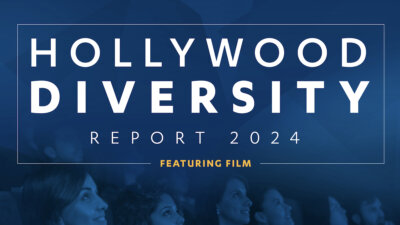 Disabled film actors have gained some ground in employment from 2022 to 2023 but remain severely underrepresented in front of the camera among the top films of 2023. Looking at two different UCLA Hollywood Diversity Report studies released in March and May of this year, just 7.1% of theatrical film actors and 4.7% of streaming film actors have a disability. This is in comparison to 26% of the U.S. population.
Disabled film actors have gained some ground in employment from 2022 to 2023 but remain severely underrepresented in front of the camera among the top films of 2023. Looking at two different UCLA Hollywood Diversity Report studies released in March and May of this year, just 7.1% of theatrical film actors and 4.7% of streaming film actors have a disability. This is in comparison to 26% of the U.S. population.
This is the second year that the UCLA Hollywood Diversity Report tracks the known disability status of actors. This followed numerous disability organizations, including RespectAbility and FWD-Doc, lobbying for disability inclusion.
The report acknowledges it was able to include disability status due to new sources of data, including Nielsen-owned Gracenote’s Studio System, which began tracking on-screen disability representation as part of its inclusion data in 2022, with the assistance of RespectAbility.
“We were honored to provide input to Nielsen’s Gracenote leading to new metrics indicating progress on representation of disabled talent on screen,” RespectAbility’s SVP Lauren Appelbaum was quoted in Variety in December 2022. “Being able to measure the gap in representation of disability is a powerful capability that equips the media industry to act and invest in representative content and disabled talent. We hope tracking representation will lead to an increase over time.”
The existence of this Nielsen data has indeed led to studies like this UCLA report to track disability representation over time. However, while there is a slight increase of representation in films from 2022 to 2023, there is still a large gap compared to the population of disabled adults in the U.S.
RespectAbility applauds the team at UCLA for continuing to utilize this data to include disability representation and encourages all researchers to ensure disability is included in diversity reports. For example, Netflix has been tracking disability representation since 2018 for their multi-year study, with reports that came out in 2021 and 2023, with another to come out in 2025.
A Focus on the 109 Top English-Language Theatrical Film Releases of 2023
The majority of top theatrical films did not include actors with a known disability in the main cast in 2023, and those with a visible disability were nearly excluded altogether. Just 8 actors (1%) had a visible disability in the top films of 2023 and no lead actors had a visible disability in top theatrical releases in 2023.
Among theatrical film leads, just 12 (11.3%) have a disability. This is an increase from 9.1% in 2022. The 12 lead actors with a known disability in 2023 reported one or more of the following types of disability: mental health (66.7%), learning (41.7%), and neurological (16.7%). Two leads had more than one known disability. There were no lead actors with visible disabilities in top theatrical releases in 2023. Among theatrical leads with a known disability, there are 5 White males, 3 White females, one White non-binary actor, 2 multiracial males, and one Black female.
Among all theatrical film actors in the top 109 films, just 7.1% have a disability. This is an increase from 5% in 2022. The most reported types of disabilities among disabled actors in 2023 were mental health (50.9%), learning (24.6%), and neurological (19.3%). In addition, 10.5% have other nonapparent disabilities and 1% (8 actors) reported more than one disability. In the top films of 2023, only 8 actors (1%) had a visible disability. Among theatrical film actors with a known disability, there were 4 Black males, 6 Black females, 3 Latinx males, 4 Latinx females, 4 multiracial males, 6 multiracial females, one multiracial nonbinary person, 18 White males, 10 White females, and one White non-binary person.
A Focus on the 100 Top English-Language Streaming Original Films of 2023
About three-quarters (74%) of top streaming films in 2023 did not include any actors with known disabilities in their main casts (less than 11% disability cast share). Furthermore, only 10% of top streaming films featured actors with disabilities in their main casts at a level approaching or exceeding the population’s share of adults with disabilities (26%).
Among the top streaming releases, disabled actors made up less than 5% of all film roles in top streaming releases and continued to be virtually excluded from all roles in 2023. Just 9% of streaming film leads have a disability (an increase from 6.1% in 2022) while 4.7% of total streaming film actors have a disability (an increase from 4.2% in 2022).
The 9 lead actors with a disability reported one or more of the following types of disability: mental health (66.7%), medical (33.3%), and learning (11.1%). Only one lead actor had more than one known disability. Similar to top theatrical releases, there were no lead actors with visible disabilities in top streaming releases in 2023. Among these actors, there were 2 White males, 3 White females, 2 Black females, one Latinx female, and one multiracial female.
Among the 34 total actors with a known disability, the majority had a mental health disability (64.7%). These actors also had the following known disabilities: deaf/hard of hearing (2.9%), learning (8.8%), medical (visible, 2.9%, and nonapparent, 20.6%), neurological (5.9%), and physical (visible, 2.9% and nonapparent, 5.9%). Four actors reported more than one disability. In the top streaming films of 2023, only 3 actors had a physical, medical, or hearing disability that was visible. Among the actors, there were 9 White males, 9 White females, one White non-binary actor, 2 Black males, 3 Black females, one Latinx male, one Latinx female, 4 Asian females, one multiracial male, 2 multiracial females, and one multiracial non-binary actor.
Which Films Have the Highest Disability Cast Share?
None of the top 20 streaming films for any viewer group had casts in which more than 30% of the top actors had known disabilities. Only 3 of the top 10 and 4 of the top 20 films had casts where more than 20% of the actors had known disabilities: You People, Leave the World Behind, We Have a Ghost, and Best. Christmas. Ever. All four stream on Netflix.
The top theatrical films have slightly higher disability representation. One of the top 10 and 3 of the top 20 theatrical films in 2023 featured a cast where more than 20% of the actors had known disabilities, and one of these had more than 30% of a disability cast share: Guardians of the Galaxy Vol. 3 (31-40%). The Hunger Games: The Ballad of Songbirds & Snakes and The Flash had between 21-30% of a disability cast share.
A few additional films had more than 20% disability cast share when looking at additional audiences. For example, when examining the top 20 theatrical films by Black audience share, PAW Patrol: The Mighty Movie had a 41-50% disability cast share and The Color Purple had a 21-30% disability cast share, in addition to The Flash. Similarly, when looking at the 20 theatrical films by Latinx audience share, Trolls Band Together and Gran Turismo had a 21-30% disability cast share. And when looking at top films by White audience share, Champions had a 31-40% disability cast share and Dumb Money had 21-30% disability cast share.
Among all these films across all demographics, the theatrical films with the highest disability cast share are PAW Patrol: The Mighty Movie (41-50%), Guardians of the Galaxy Vol. 3 (31-40%), and Champions (31-40%).
Looking Toward the Future
Disability inclusion drives both equity and profitability. With the market size of the extended disability community being 63%, opening the inclusion umbrella is not just the right thing to do, it also is economically smart, as the disability market is valued at more than $13 trillion when including friends and family.
Including disabled actors playing both characters with disabilities and those without disabilities does not happen by accident. What we see on screen influences how we act in real life, but that is dependent on productions choosing to include disabled individuals in diverse and authentic portrayals. This can help to remove the stigmas that currently exist about interacting with disabled individuals.
While this report provides trackable data of disabled actors, the report does not yet track the disability status of directors or writers – but it does share data by gender and race for these roles behind the camera. Currently, no major production company or studio publicly tracks disability status for its employees and crews, so the data does not yet exist. More authentic disability stories will not be portrayed on screen until there are more disabled people hired in all roles behind the camera. RespectAbility’s Entertainment Lab seeks to help solve this issue, with nearly 200 alumni and current Fellows now working at a variety of studios and in writers’ rooms. RespectAbility urges all representation studies to include disability data both in front of and behind the camera. This will ultimately help lead to more authentic representation.






